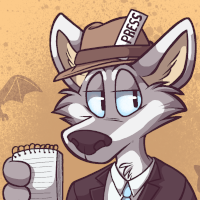La Saga d’Atlas & Axis, T. 3, by Pau – Book Review by Fred Patten
by Pup Matthias
Submitted by Fred Patten, Furry’s favorite historian and reviewer.
 La Saga d’Atlas & Axis, t.3, by Pau.
La Saga d’Atlas & Axis, t.3, by Pau.
Roubaix, France, Ankama Éditions, November 2015, hardcover €12.90 (60 + [3] pages).
Once again, Lex Nakashima & I present our conspiracy to get you to read French animalière bandes dessinées that aren’t likely to be published in English.
Has it really been 2 ½ years since I reviewed tomes 1 & 2 for Flayrah? Well, Jean-Marc Pau has been busy. Not only has he written & drawn this volume, he has made a “movie” of the whole series. If you look closely, you can find a little animation in it. The 3:25-minute “movie” starts with images from the first two albums; tome 3 starts at 2:09 minutes.
I described La Saga d’Atlas & Axis as “Their world looks like a doggy version of Astérix & Obélix …” Cutely drawn but without the humor. The setting, allowing for the anthropomorphic animals, is around the 9th & 10 centuries when the Vikings were taking over Armorica so thoroughly that it’s been called Normandy ever since. This series also differs from Astérix & Obélix in being one continuous adventure rather than standalone albums.




 Dudley & Gilderoy: A Nonsense, by Algernon Blackwood.
Dudley & Gilderoy: A Nonsense, by Algernon Blackwood. Victernus, by Baumarius.
Victernus, by Baumarius.
 Hunters Unlucky, by Abigail Hilton. Illustrated by Sarah Cloutier. Maps by Jeff McDowall.
Hunters Unlucky, by Abigail Hilton. Illustrated by Sarah Cloutier. Maps by Jeff McDowall.
 Cat Crimebusters and Other P.I.s on Paws, Part 4
Cat Crimebusters and Other P.I.s on Paws, Part 4 Endtown 3, by Aaron Neathery. Foreword by Carol Lay.
Endtown 3, by Aaron Neathery. Foreword by Carol Lay.